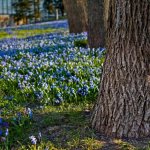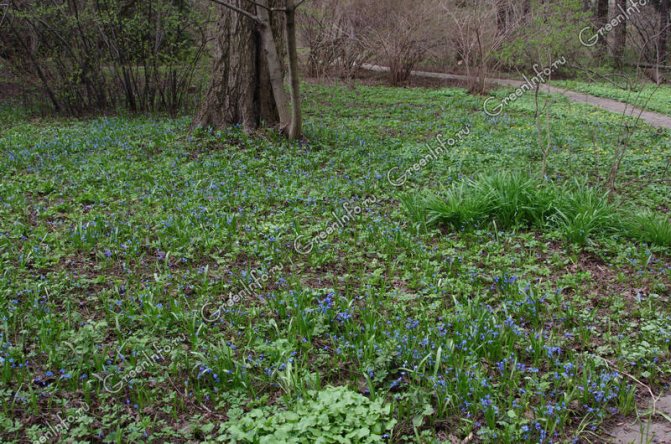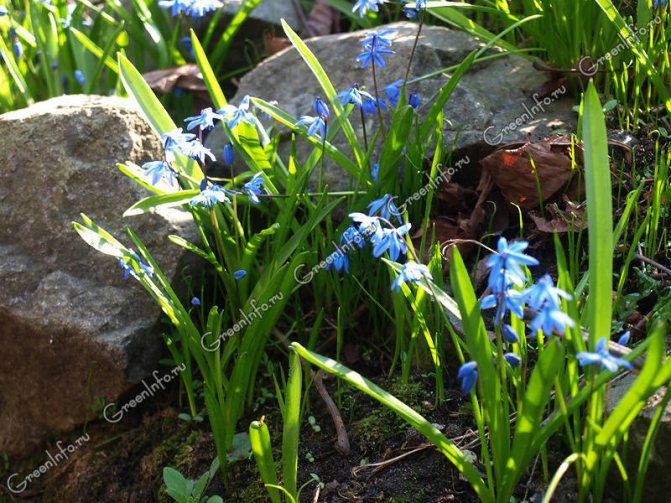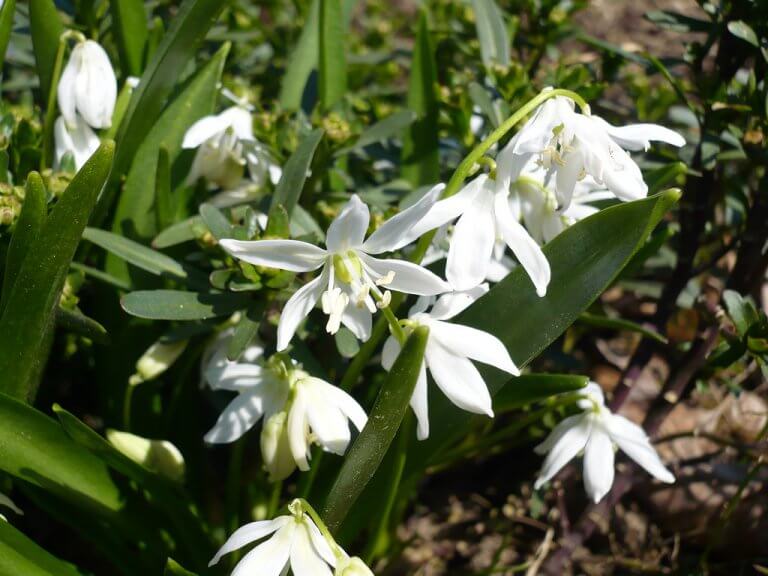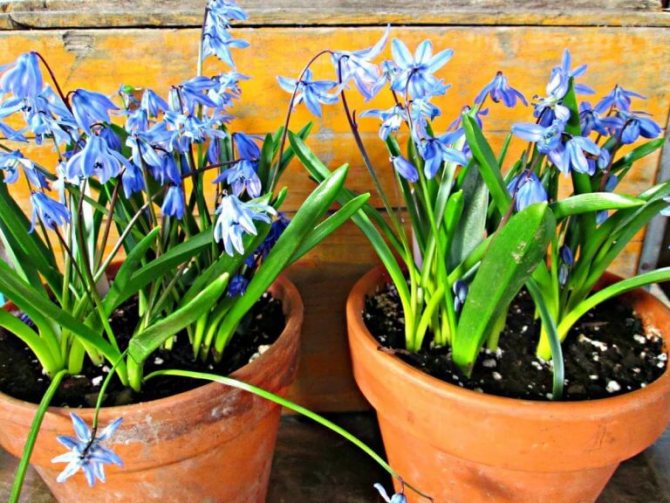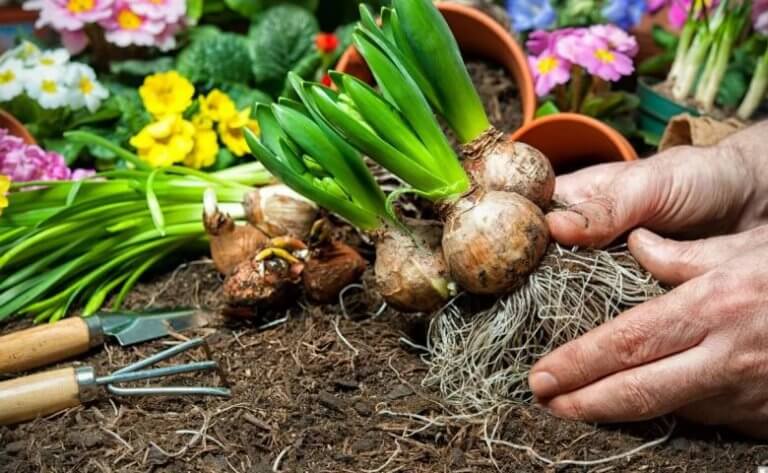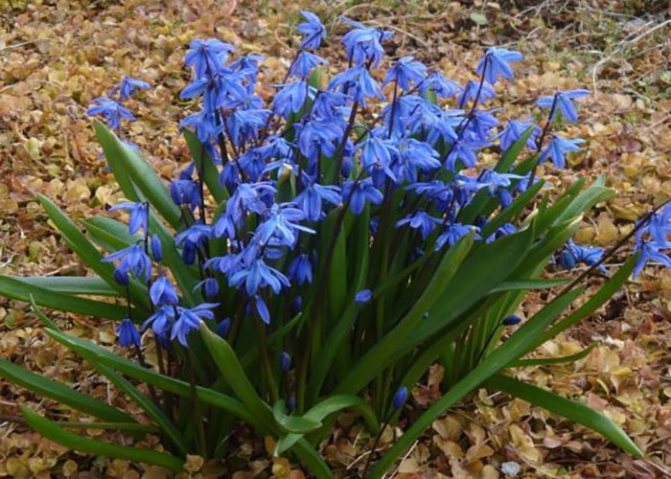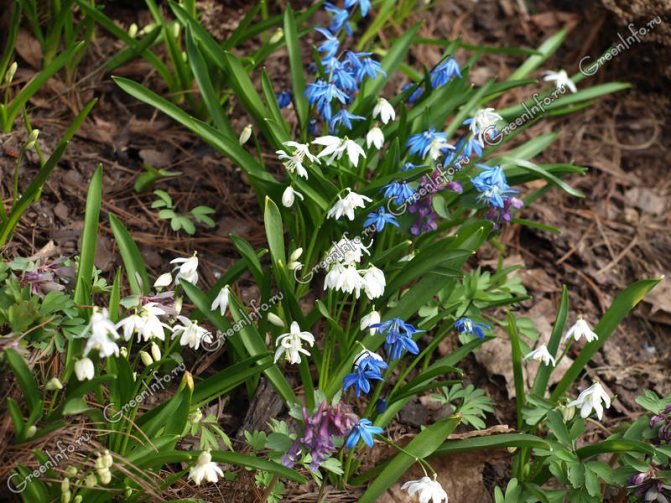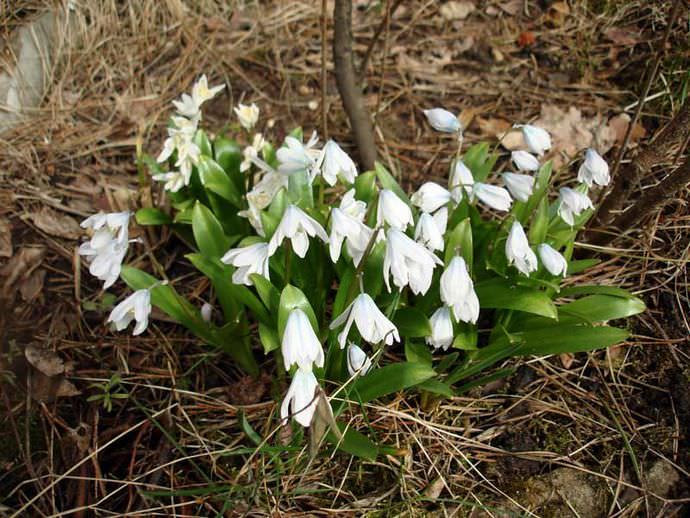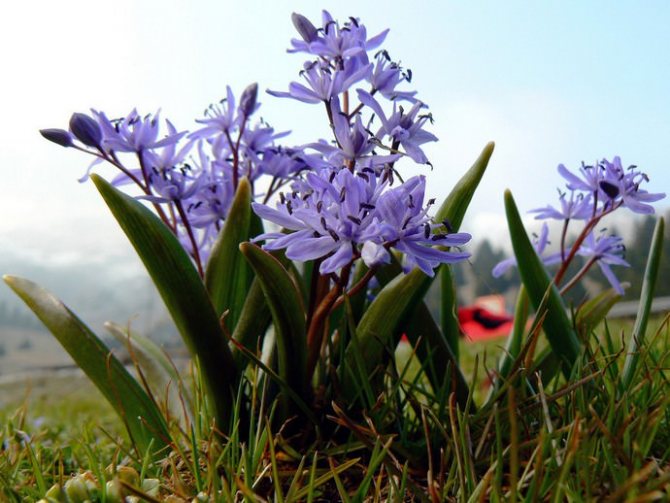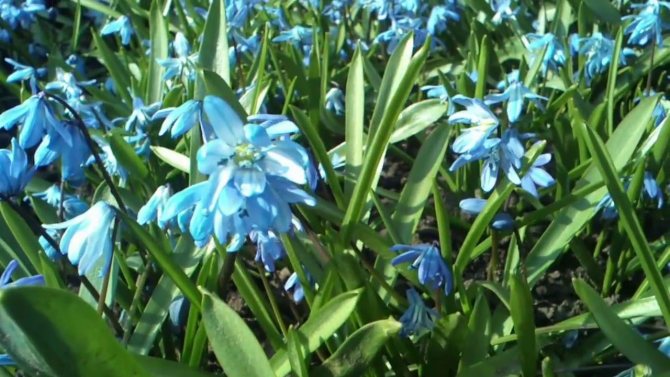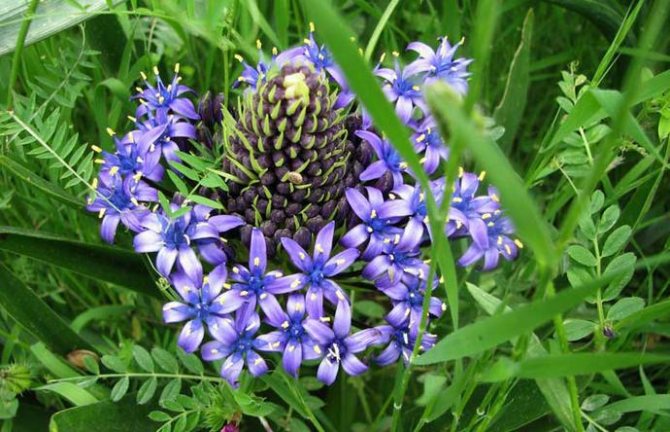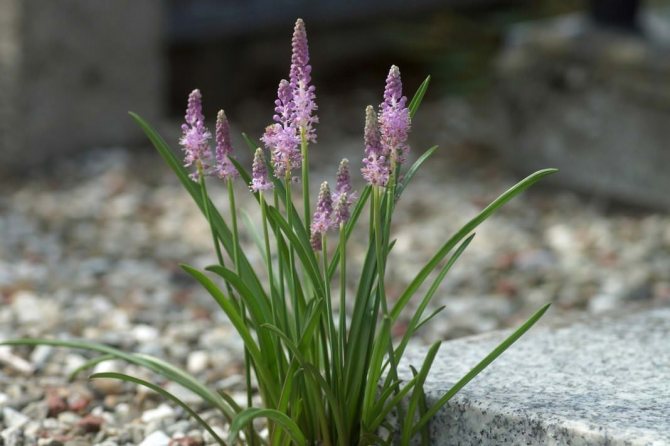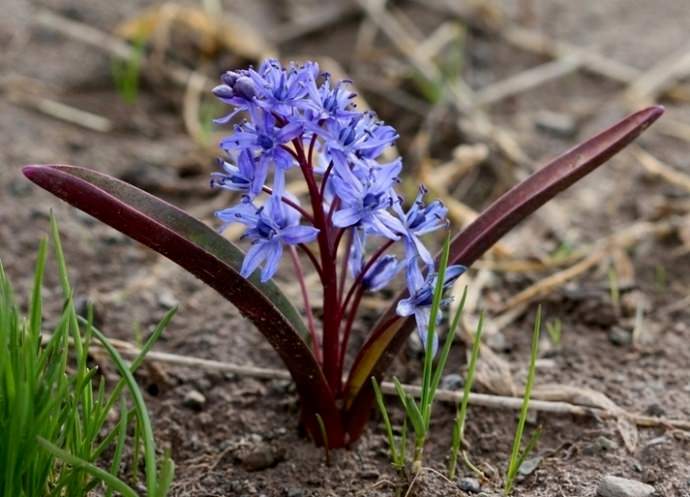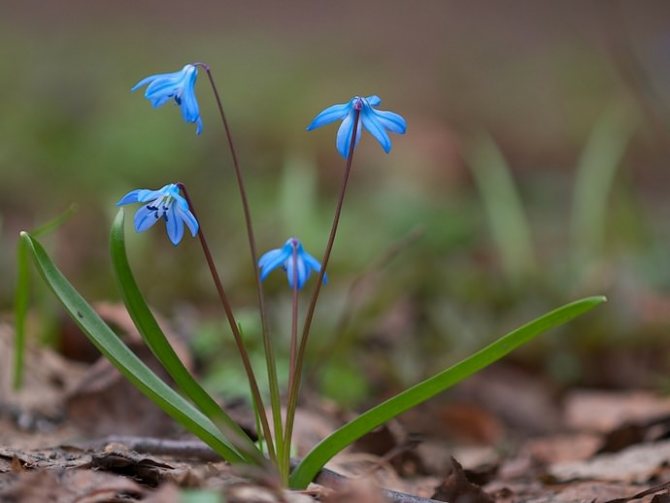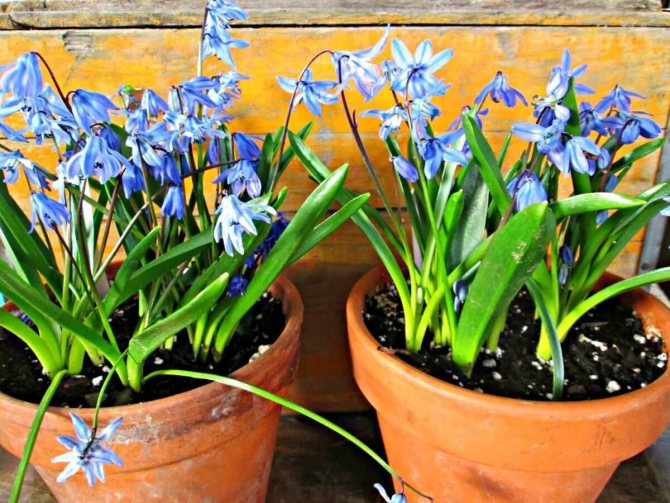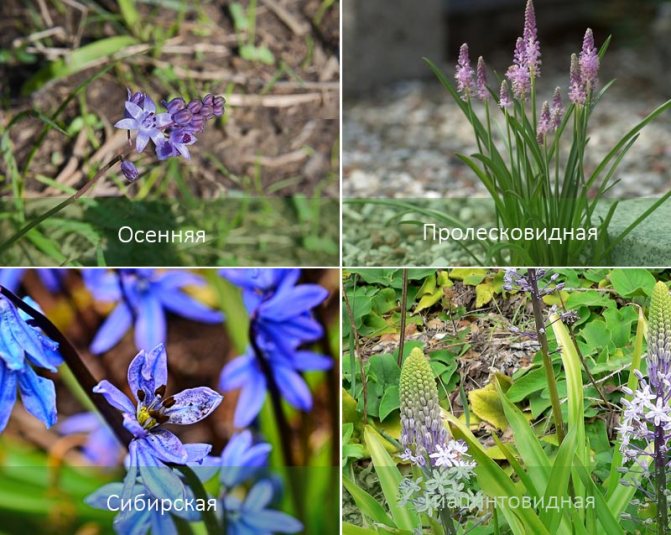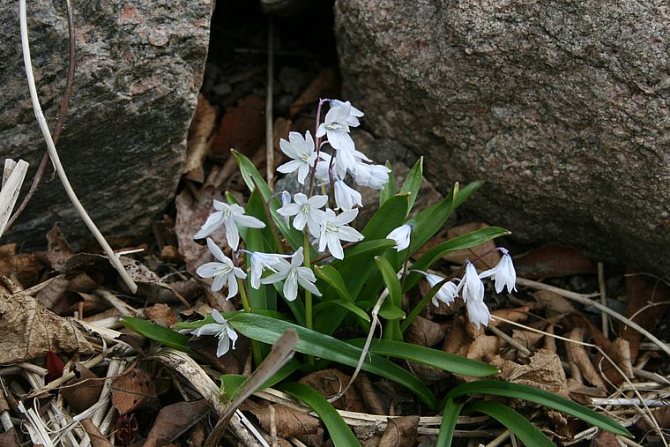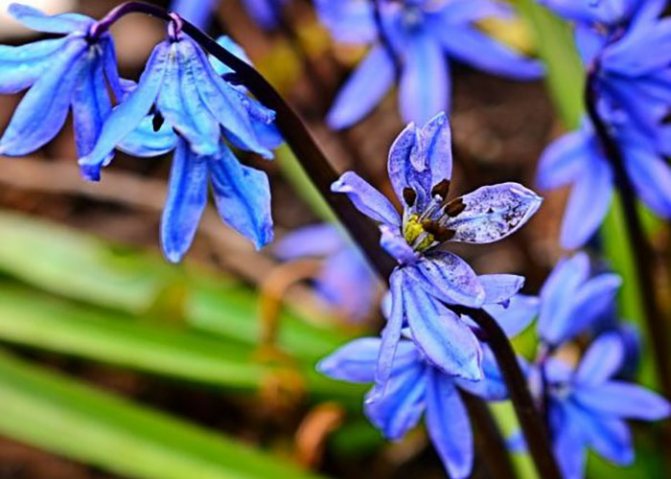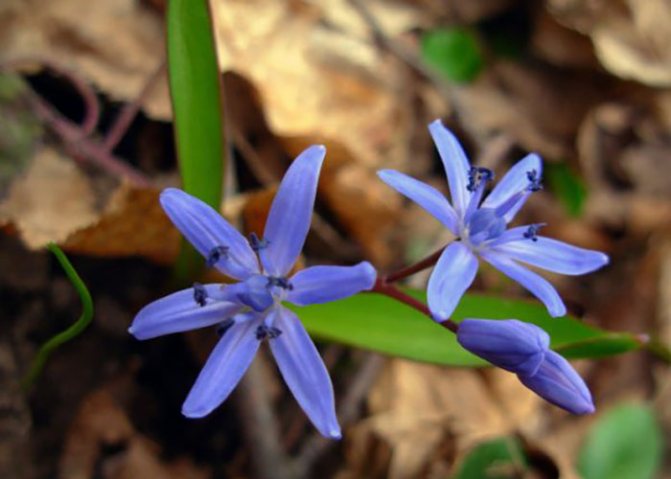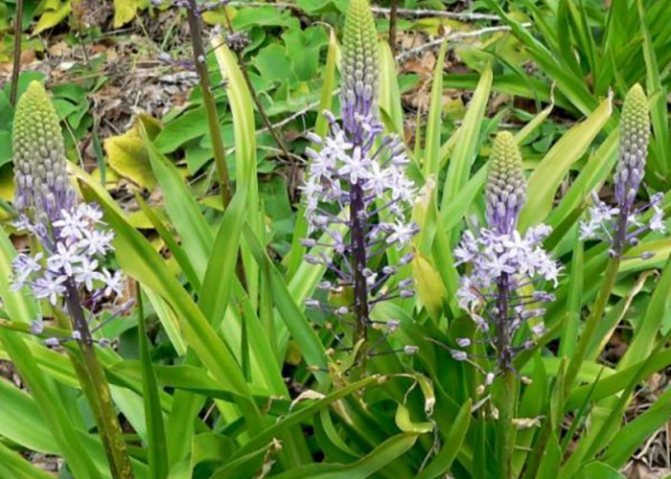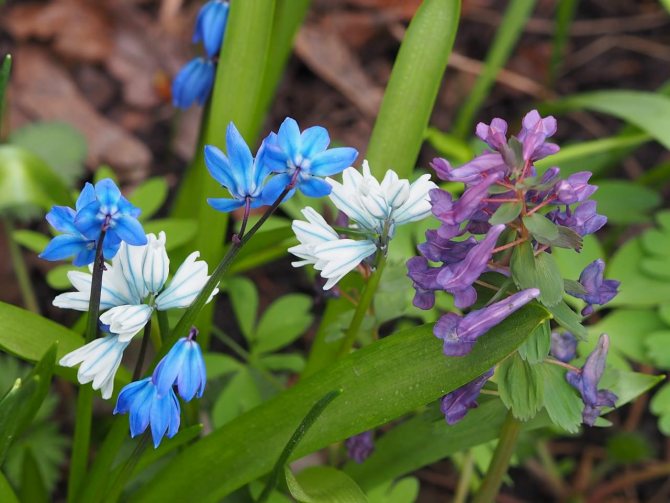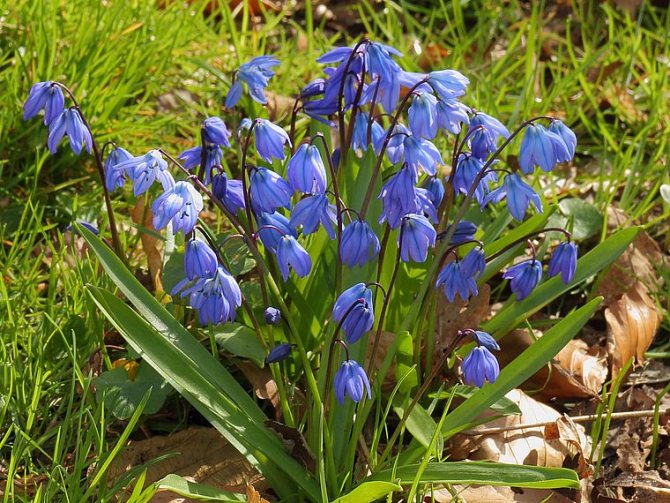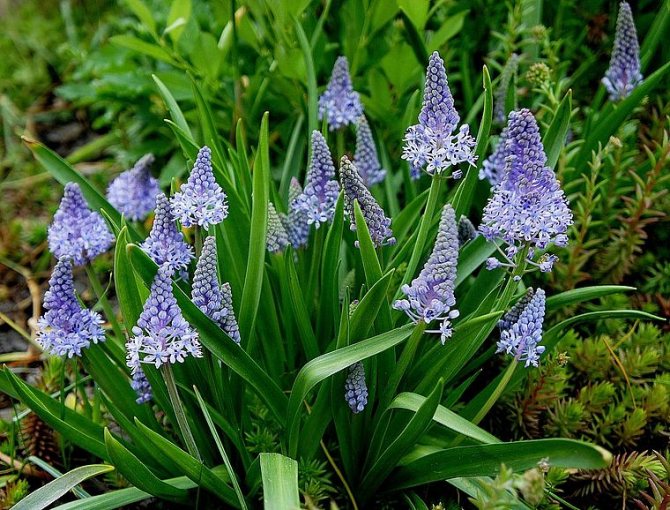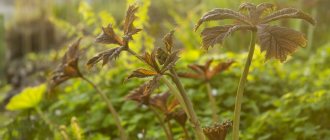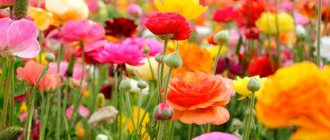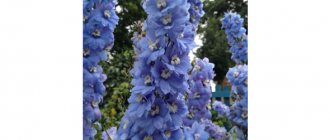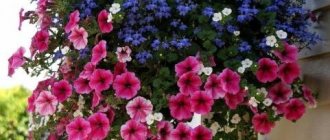Scylla, popularly called Proleskaya, is the first herald of spring. The delicate flower has incredible strength, making its way through barely thawed soil. Scylla can be called an amazing flower also because even botanists are divided in opinion, reckoning the flower either to the Liliaceae family, or to Asparagus or Hyacinths.
But it should be noted that these families, despite a number of morphological differences and features, have much in common. Proleska has more than 85 varieties. The plant feels great in the climatic conditions of both Europe and Asia and Africa.
The use of scilla in landscape design.
Undemanding care allows you to use this plant almost anywhere. Scyllas make beautiful borders. The bright blue edging of the garden paths pleases at a time when there is still snow in shady places.
To create a rich color spot, bulbs are planted in the soil in large quantities. Such bright spots effectively enliven conifers in spring.
Scylla grows well in the sun and shade, so they can be found under the bushes and trees of the garden. In orchards, they settle in near-trunk circles.
Classic accommodation option - and. Bright blue or light blue flowers look great against the background of decorative stones of any breed.
Scyllas go well with whites, yellows, and early ones. They are often planted in the neighborhood with drying bulbous leaves covering their greens by the end of May.
The tips for caring for these flowers are very simple - they do not require any maintenance at all. If the soil is loose enough, it grows like a normal weed.
Location
... Grows well in the sun and in shady places. In too dry places under the scorching summer sun, they can disappear. For early flowering, they choose places where the snow melts very early, the southern slopes, for example. In shady places, flowering will come much later, when the snow has completely melted there. In this simple way, you can extend the flowering by more than a month.
When you hear the name of these flowers, the myths of Ancient Greece with their Scylla and Charybdis involuntarily come to mind. But how terrible Scylla is in ancient Greek mythology, so beautiful is she in the garden in early spring. In our area, another name is more popular -.
She pushed me to study these beautiful flowers with my spring garden, where, as usual, the woods grew. These flowers got their name "scilla" thanks to the sea onion plant (its ancient Greek name Skilla is spelled as Scilla in Latin transliteration). Scylla belongs to the Asparagus family, although earlier it was referred to as Liliaceae or Hyacinths.
Scylla is one of the first plants of spring, many mistakenly mistake the white flowers of the scilla for. They can also be pale blue, blue, pink or purple, depending on the species and variety.
Fertilizers
Although the parent species of woodland growing in the wild are unlikely to receive additional fertilization, garden species need it. If you want to get a strong plant with abundant and long flowering, not susceptible to disease, feed it.
The most suitable time for feeding is, of course, the beginning of spring, before the start of sap flow. You can do this process in late autumn.
No special fertilizers are required. A standard mineral kit in the form of nitrogen, potassium and phosphorus is fine.For autumn feeding, it is better to choose granular types of fertilizers, for spring - liquid fertilizers.
Growing a scilla
Scylla landing
Due to its unpretentiousness, Scylla is a welcome guest in, and all kinds.
Many "flower gourmets" use scilla for New Year's, planting bulbs in pots with drainage, leaf peat, fertile soil and coarse river sand.
As I said, Scylla is not picky, loves neutral or slightly saturated with leaf peat and rich.
Does not like swampy places, the soil should be loose and moist. It is better to plant this plant in the shade, but the scrub will also grow in lighted places.
Reproduction of scilla
1. Seeds
You need to collect the seeds of Scylla then,
when the boxes turn yellow and start to crack
(this is about the end of June). After collecting them, they must immediately be sown into the ground, since their germination rate is very low.
After a few years, the spines will bloom. And it is advisable to leave them in one place for about 5 years, so that the plant multiplies flower stalks and forms more "children".
2. Bulbs
During the growing season, an adult bulb gives on average about 2 children. When the foliage of Scylla dies off (June), feel free to plant the children in the ground on
about 3 cm deep and about 5 cm apart
.
Self seeding is possible in Scylla. Therefore, if you find it in the wrong places after the snow melts, do not be surprised.
Characteristics
Scylla is a bulbous perennial. Its bulbs are round or egg-shaped. They are covered with brown, purple or dark gray outer scales.
The leaves are basal, linear. They appear simultaneously with the inflorescences or a little earlier. A feature of the leaves is their dependence on the weather: on warm and sunny days, they straighten and stretch towards the sun, and on cold and cloudy days they are pressed to the ground.
The plant has no leaves on the peduncles. The inflorescences have one flower and grow in the form of a brush. The fruits of the plant are in the form of a box. Inside it are black ovoid seeds.
Scylla is a primrose flower. Its flowering begins in early spring. However, there are varieties that bloom only in autumn.
Scylla care
Scylla does not require special care, but if you feed it in early spring before flowering and, it will bloom and multiply better.
In the first year, Scyllus needs shelter for the winter
especially if you planted it in an open place. You will find recommendations for sheltering the bulbous in the article.
If you need to transplant or divide the plant, then try to do it not earlier than in 3 years
... For the first time, the planted scilla is watered and loosened the soil surface, it is possible so that moisture remains and there are no weeds.
Susceptibility to diseases and pests
Everyone knows that it is better to prevent a disease than to fight it, so before planting, the plant bulb should be carefully examined and checked. Onion hoverfly larvae penetrate the bulb and gnaw it from the inside. The planting material you have selected may already be contaminated. Insecticides should be used to treat the soil where there are traces of the root onion mite. They love to feast on the bulbs of Scylla Medvedka and Khrushchev. It is desirable to destroy them mechanically, by removing the larvae and adults while digging the soil.
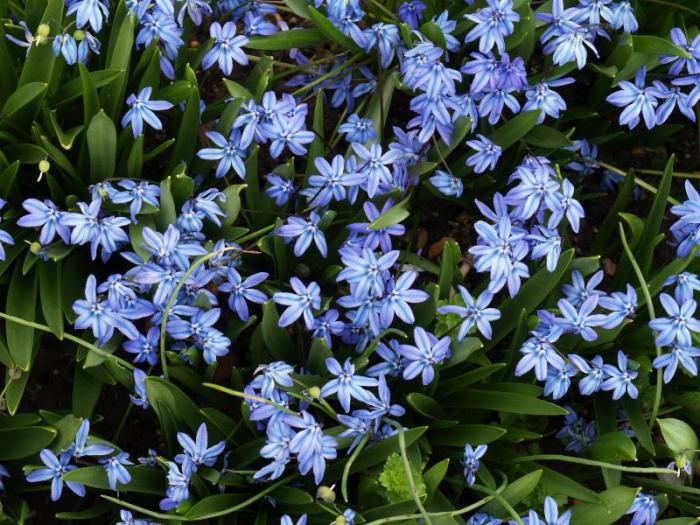
Not only insects can lead to the death of a plant, but also stagnant water with abundant watering and poor drainage. This causes the appearance of a fungus that provokes rot. You can try to save the bulb at the initial stage of the development of the disease by dipping it for a while in a solution of potassium permanganate or fungicide. In the spring, plants can be watered with this solution to prevent disease.
Siberian beetle, planting and caring for which does not require professional skills, in a suitable not stingy soil will delight with bright flowering and abundant growth for more than one year.
Types of scilla
There are about 90 types of Scyllas, "scattered" in the meadows of different European countries, including the vastness of our country.
Double-leaved scrub
When the garden just wakes up from sleep, it begins to bloom. She pleases the eye with blue, white, pink flowers. It blooms in the second half of April and lasts about 2 weeks. This is a low plant (up to 15 cm) with 3 peduncles, on which, like stars, about 15 flowers are scattered. In the south, you can find a double-leaved forest with delicate white flowers - in the Crimea, the Mediterranean. This scilla species has a very strong and pleasant scent that attracts butterflies and bees.
Siberian Proleska
Later, it begins to please the eye, it blooms with beautiful blue or white flowers.
She has several beautiful subspecies: Scilla sibirica subsp. caucasica,
S. sibirica subsp. armena
(Siberian redhead, Caucasian subspecies, Siberian redhead, Armenian subspecies), etc.
The name of the species was given by mistake, the birthplace of the Siberian Scylla is the south of Russia, the Caucasus, the Crimea, and it does not grow in Siberia. In the spring, it forms a “carpet” of beautiful, densely growing blue flowers. Leaves of this type of scilla appear along with flowers.
When the seed pods ripen, the leaves dry out. Scylla of this species rests all summer, and in the fall begins to gain strength in bulbs and form the rudiments of leaves and flowers. The flowers of the Siberian forest, like an alarm clock, open their beautiful cups by 10 am and close by 5 pm.
This species is very sensitive to the sun: if it is raining or cloudy, the flowers will not open. The leaves of the Siberian Scylla are like "solar batteries": in cloudy, cool weather, they practically lie on the ground in a horizontal position, absorbing ultraviolet light as much as possible, and in hot, sunny weather they rise almost vertically to the stem and flowers. Propagated by seeds. During vegetative propagation, the species is not renewed and the plant does not rejuvenate.
Proleska Tubergen, or Proleska Mishchenko
Later, Tubergen's spade (Scilla tubergcniana, Scilla mischtschenkoana) blooms later than the others.
She pleases the eye with blue and white flowers. On the perianth leaves, like a vein, a blue stripe is visible. Leaves are juicy green, long, elongated. One bulb gives birth to about 4 small arrows (about 15cm), on which, like stars, about 7 flowers grow.
Proleska Rosen
At the same time, at the end of April, it blooms Rosen's scrub (Scilla rosenii)
... The bright green leaves seem to wrap the stem around. If you walk through the meadows of the Caucasus, she will definitely meet you there, "smiling" with 1-2 beautiful blue flowers with a lilac hue. Anthers of cyclamen-like flowers are bright blue, filaments are flat, snow-white.
Since the flowering period is the same.
Description and features of forest trees colors
They got their other name as woodlands - Scylla
... Plants stand out with long lanceolate leaves. Peduncles with small buds appear almost simultaneously. One shoot can have from 5 to 20 inflorescences, collected in a panicle. It all depends on the species.
Early flowering encourages people to use it for cutting. Therefore, they belong to an endangered species. From here, all are entered streams to Krasnaya.
Flowering lasts two decades. Bloom resumes only next spring.
Scylla is a perennial plant with a bulbous root system responsible for preserving nutrients to the flowers of the scrub.
After the leaves wilted, the bulb successfully hides in the ground under the crown of leaves that have fallen from a tree, growing grass until the spring of the next season. Some species can bloom in summer and autumn. Florists often grow varieties of spring flowering.
Planting and breeding forest trees
Scrub plant
can grow in open space and in partial shade of trees, especially deciduous ones. The sun is inhabited mainly by meadow woods. Hot sites are preferred by Pushkin and autumn woods. If you plant them in your personal plot, you should prepare high beds for planting.
Scylla prefer nutritious soil, with a content of leaf humus, mineral in the soil. The composition of the earth can be any. Exception for acidic soil. Maintain a step between the bushes up to 10 cm. The planting depth should be at the height of the bulb.
Reproduction by baby bulbs:
- a bush for propagation is selected no earlier than 3 years;
carefully disconnect the babies, there are at least four of them near the mother's bulb;
land on a permanent place;
add earth mixed with mineral components and leaf humus to the hole;
baby bulbs are planted at the depth of growth;
carry out the breeding procedure as soon as the leaves die off;
bulbs can also be planted in boxes and stored in a cool place until autumn, if breeding occurred in the spring;
in September they are planted in open ground;
care is the same as for adult specimens.
Seed propagation is carried out with freshly harvested planting material. Although this is not necessary. The screech reproduces well by self-sowing.
If you do not like how they are scattered around the garden, you can plant them in the place that is considered more profitable for you. A transplant, even in blooming, will not hurt them. Flowering from planting with seeds will come in 3 years.
There is another breeding method - cutting off the bottom of the bulb. This method uses containers. When small children appear on the bottom, they are carefully separated with tweezers and transplanted for growing. In the fall, they land on a permanent place.
Two-leaved Siberian sprouts are planted in flowerpots for distillation. For this, the soil is prepared: peat, humus and drainage. A large and strong bulb sits in a pot in November.
The container is sent to a dark place with an ambient temperature of 5 degrees C for several months. After 60 days, the bulb is taken out to a bright place, fed, watering is resumed, but the temperature should be 15 degrees C. In the spring, the plant will bloom.
Care of the forest
Per Proleskom - Scylla
the following care is required:
- Watering should be done in the morning in moderation. For the bulbs, waterlogging is destructive. When irrigating, do not spray, try to get strictly on the soil.
Cover the ground with a layer of mulch to preserve moisture and nutrients. It is worth noting that the plant does not like sour soil. Therefore, do not use elements that increase acidity, for example, needles, as a quality.
Scylla responds well to feeding. The decorativeness of the bushes is much better and is protected from diseases. Use mineral components as fertilizers before flowering in spring (nitrophobic) or in autumn. Moreover, use granules in the fall, and liquid top dressing in the summer.
Transfer. Species can vary in flowering time. Transplanted in the spring, usually those species that bloom at this time. The procedure begins after the leaves die off. If flowering is in the fall, the transplant is carried out 30 days before it.
Diseases and pests:
- Gray rot. Symptoms: A gray coating appears on the leaves and on the top of the bulb. Struggle: remove diseased specimens, cut off the affected areas of the bulb, grease with ash. If the stage is advanced, apply fungicides.
Mouse rodents. Gnaw the leaves in the spring and eat the onion. For such pests, a fence will help, where to scatter baits around the perimeter, dig a little with soil. Otherwise, you can poison the birds.
Meadow bream. Drinks juice from an onion. Fight it with insecticides, and in order to prevent it, treat it with Akarin before planting the bulb.
Species types
Proleski or Scylla changed their positions about Rod's belonging to the family. For many years they were the Liliaceae family. Modern scientists believe that it is Asparagus. There is a third group of scientists who consider them to belong to the Hyacinth family. Hence the collapse and inconsistencies. In any case, the genus has up to 80 species.
Varieties overflow, description:
Scilla autumnalis
... Autumn forest - flowers, photo.
Blue Scylla is a familiar thing, but the inflorescences of a purple shade look unusual and original.Flowering period July-August. Unlike other varieties, the leaves (25 cm) are narrow with a groove, green in color. There are several peduncles in the bush, each with a panicle of 5-6 buds.
In the photo there is a blue scilla
Bell-shaped forest, photo
as nothing better will show her beautiful appearance with delicate buds of blue with a blue tint. She is Scylla bell-shaped (Scilla hispanica) blooms in the last decade of May. In winter, a cover with a layer of mulch is required for good wintering in our regions.
In the photo is a bell-shaped scaffold
Siberian Proleska
(Scilla siberica). Beautiful inflorescences of a blue-blue hue. Fleshy leaves with a smooth surface jump out of the ground in April. They are followed by peduncles with 5 buds. The bush stretches up to 20 cm.
Flowering and growth continues for several weeks. Then the leaves die off and the bulbs hide in the ground, under the cover of fallen leaves until next spring. It grows in the southern part of Russia, but not in Siberia. The most popular type among florists, grown in the garden.
Siberian Proleska
Double-leaved scrub
(Scilla bifolia L.). The bush got its name because of the number of leaves. Each outlet has two sheets. A plant with a small bulb (1.5 cm) produces flower stalks with miniature buds of bright blue, pink, purple hues.
Sometimes the flower is called the blue streak.
Habitat: Transcaucasia, Crimean forest edges, Voronezh and Kursk regions. The flowering period is May. This species is successfully used for home planting.
Double-leaved scrub
In horticultural culture, bifolia var is used. Purpurea with purple buds. Buy woodlands
you can go to the flower shop or order the bulb online. Couriers will deliver directly to your home.
Forest scrub.
Grows under the shade of trees. stands out well against the background of bare trees. Since it blooms much earlier than they do. The inflorescence is pale blue.
Forest forest flower
La Grandes
(La Grande). Many people think that this is a snowdrop, but it is similar only in color.
In the photo of La Grandes
Scilla (Latin Scilla) or scilla is a genus of bulbous plants of the asparagus family (previously referred to as hyacinth, lily). The people are better known under the name "blue snowdrop".
Landing
Planting a plant will not be difficult even for a novice gardener. They are usually not planted singly. They are used for rockeries, mixborders, flower beds, alpine slides or rabatoks. They are also often planted around garden trees.
Boarding time
Since the scilla adapts easily to new conditions, it can be transplanted even during flowering. However, for better health of the plant, it is better to transplant them at a certain time. Experienced florists recommend:
- Repot the spruce trees blooming in spring from about mid-June, after the leaf plates die off;
- Transplant those blooming in autumn one month before the formation of peduncles, approximately in August.
Determine the place
The first thing to do is determine the location. The place where the flowers will be planted can be sunny or shaded. This largely depends on the variety and flowering time. Spring ones feel better in the sun, and autumn ones - in the shade.
Priming
A soil with a rich organic composition, including leaf humus and mineral components, is best suited for a plant. For the full development of flowers, you can mix garden soil with forest soil, since it contains semi-processed tree bark and foliage. The acidity for the plant should be in the range of 6.5-7.0.
How to plant
Make the required number of planting holes. Their size is approximately 8 cm x 8 cm, and the distance between them is 5-10 cm. Dip the bulb into the hole by 7-8 cm and cover with prepared nutritious soil mixture.
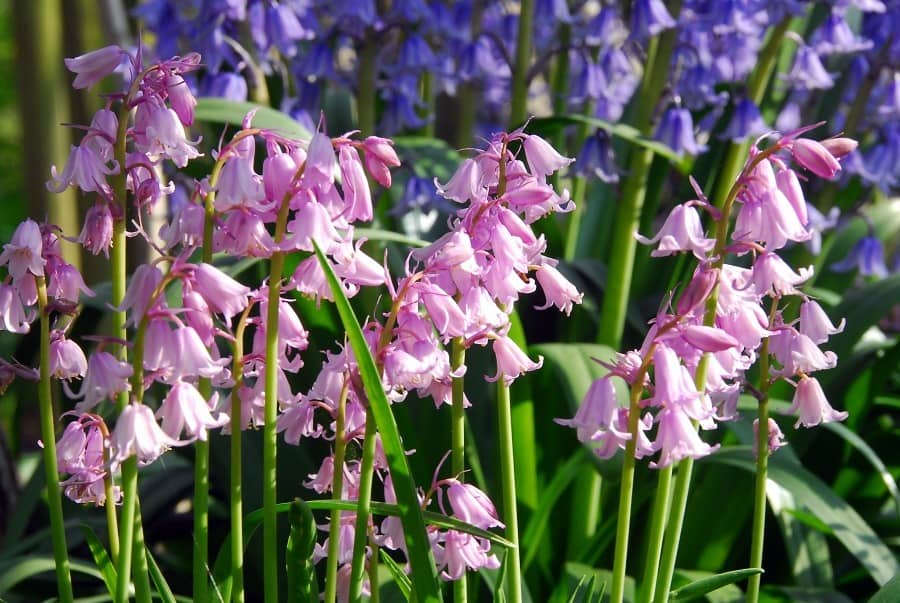

Description
Representatives of the scrub genus belong to low plants, do not exceed 40 cm. The bulbs are ellipsoidal or ovoid, about 2 cm high, the outer dry scales can be of different shades depending on the species characteristics.Leaves are elongated, linear, basal, have parallel venation, about 20 cm long.
Peduncles are leafless. The flowers are actinomorphic, they can be white, blue, pink or purple, solitary or in inflorescences. They have the shape of a drooping bell with 6 petals. The fruit is a capsule with black ovoid seeds, in some species with a fleshy appendage.
Redwoods belong to the ecological group of ephemeroids, that is, after the fruits ripen, the growing season ends, the plants wither, but do not die, but only pass into a dormant period. Blooms in early spring (April-May).
Redwood flowers
There are at least 90 species in the genus. Noteworthy:
P. siberian
(S. siberica). Quite often found in culture since the 18th century. It has many subspecies, varieties based on it have been bred. The distribution area includes Eastern Europe, the European and southern parts of Russia, the Crimea, the Caucasus, the countries of the western part of Asia. It is absent in Siberia, despite the name. In nature, it grows on the edges of deciduous forests.
On each peduncle 10-20 cm high, several blue, less often violet-blue, bright azure or white flowers are formed. The leaf plate is broadly linear, equal in length to the peduncle or slightly shorter. The flowering period is 15-20 days in April-May. The bulbs are ovoid, brown-violet in color, about 2 cm in size. It is quite easy to naturalize and can give abundant self-seeding.
Screech in the wild
P. double-leafed
(S. bifolia) grows naturally in southern Russia and the Crimea. The flowers are blue, blue, purple-violet, rarely white or pink. The species is undersized, does not exceed 15 cm in height. On one peduncle there can be up to a dozen flowers with a wonderful aroma.
Blooms in April (second half), flowering lasts about 15 days. As the name suggests, it has only two broad-linear leaves surrounding the lower part of the peduncle. The bulb is elongated, slightly more than 2 cm long and 1.5 cm wide, the scales are light. It has been used in floriculture for a very long time; with good care, the inflorescences are very lush. Feels better on rich, but loose soils.
Scallop against a background of yellow daffodils
P. pushkiniform
(S. puschkinioides) is found mainly in Central Asia. It got its name because of its similarity to Pushkin. Flowers have characteristic blue longitudinal stripes, form rather large inflorescences. The leaves are wide, linear, dense, there are only 3-4 of them in each plant. Blooms in May for about 2 weeks. Can give self seeding. Grows best in open, sunny areas.
P. Tubergen
(S. tubergeniana) originally from Iran, cultivated in floriculture relatively recently. Inflorescences of pale blue flowers bear short peduncles up to 12 cm high. It blooms very luxuriantly in April for 15-20 days. Leaves are linear, slightly longer than the stem, bent to the ground. The onion is round, 2.5x2.5 cm in size.
Proleska Tubergen
P. Rosen
(S. roseni) is undoubtedly very interesting. Found in the Caucasus. It has the largest flower in comparison with other representatives of the genus - up to 5 cm in diameter with bent tepals, like cyclamen. The flowers are blue or white, located 1-2 on the peduncle. Plant height up to 20 cm. The leaf plate is about 15 cm, linear, narrowed at the ends. The bulb is ovoid, 3x2 cm in size, the scales are light. This wonderful perennial is undeservedly little common in floriculture, although it is unpretentious, and with proper agricultural technology it looks even brighter and more elegant
P. autumn
(S. autumnalis) grows in the Crimea, southern Europe, Asia and North Africa. It throws out several peduncles up to 20 cm long. The flowers are lilac-blue, pale lilac, may have purple edges, form racemose inflorescences consisting of 10-20 flowers. The leaves are narrow, linear, up to 25 cm. The bulb is relatively large, up to 5 cm high and 4 cm wide, the scales are light gray.
And although it is somewhat inferior in decorativeness to some other Scyllas, its distinctive feature is the atypical flowering time for a kind of flowering time - the beginning of August.This species is very demanding to care for, since it grows in nature in mountainous areas, and does not tolerate thaws in winter. Prefers open areas and direct sunlight, well-drained areas.
There are a few more beautiful, but less common types. This, for example P. grape
(S. peruviana), forming an interesting large conical inflorescence, which sometimes even consists of 100 flowers. Not a typical representative of the genus - Scylla Chinese (S. chinensis). This perennial is capable of reaching 40 cm, pink flowers form a dense brush, and the flowering time is autumn.
Siberian Proleska: photo and description, features of the species


Siberian Scylla is recognizable by its long, tall leaves with parallel venation. Flowers have ray symmetry. There are 6 petals in total on a flower. Color is predominantly blue, light blue, white. The diameter of the flower varies from 1.5 to 3 cm. The bulb 2 cm in diameter is intended for the supply of nutrients. Flowering occurs in mid-spring, in summer it is dormant. Blooms no more than 20 days. Flowers are pollinated by bumblebees and bees.
The Siberian blueberry flower is very fond of the sun, it does not open in cloudy weather. The light-colored cap, made up of a group of mechanical tissue cells, at the top of the leaves helps the plant to break through the frozen soil, a layer of compressed melt snow and an ice crust. Propagated by seeds, which are taken away by ants.
Growing and care
Blue snowdrop can be successfully cultivated in the sun or partial shade. For most species, partial shade under trees or shrubs is preferable. They feel good on loose, fertile soils. The soil can be moist, but not waterlogged, and grows poorly in conditions of high acidity. The most common types of woodland in cultivation and care are unpretentious and do not require any special technologies.
Scylla responds well to spring nitrogen and potash feedings. Watering is required as needed. The soil is loosened only for the first 2 years after planting. It does not lose its decorative effect, even if it is not transplanted for 7 or more years. Can be used for forcing, for example, for the New Year.
Blackheads winter well without additional shelter, are frost-hardy. Plants located in open areas respond well to autumn mulching with leaf humus. This lightweight cover retains extra moisture and prevents weeds from spreading.
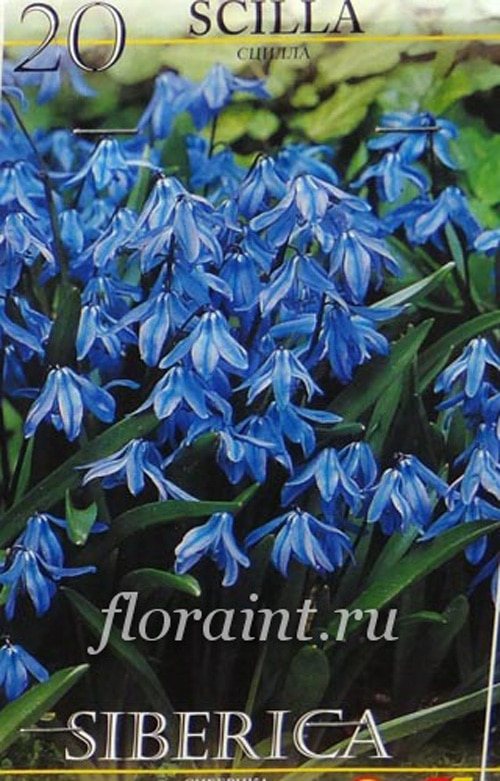

Spruce bulbs are rarely available for sale
Suitable soil
Siberian Proleska, a photo of which is presented in our article, prefers loose soil rich in leaf humus. Dry sandy soil requires deeper planting. If the spill is not grown in the open field, then there must be drainage in the pot at the bottom. Siberian scrub does not accept acidic soils. Slightly acidic or neutral soil will be optimal. He loves mulching, that is, covering the root zone with various materials such as leaves, bark of deciduous trees, straw, pebbles to preserve moisture and useful soil properties. The needles and bark of coniferous trees are not suitable as a shelter for this plant.
Reproduction
Some types of scillas give significant self seeding. To grow woodland with seeds, you need to collect them in the middle of summer, when the fruits begin to turn yellow and crack. After harvesting, the seeds must be planted immediately, since the germination rate drops sharply over time. Young bulbous plants will begin to bloom only after a few years. Until that time, it is better not to touch them, not to transplant them.
Propagation of woodland with bulbs gives good results, but it is desirable that the plant grows in one place for at least 2, and preferably 4 years. During the growing season, a healthy adult bulb produces 2 babies. In June, they can be separated and planted. It is highly discouraged to keep them out of the ground for a long time. Children are planted at a distance of two diameters of the bulbs from each other.
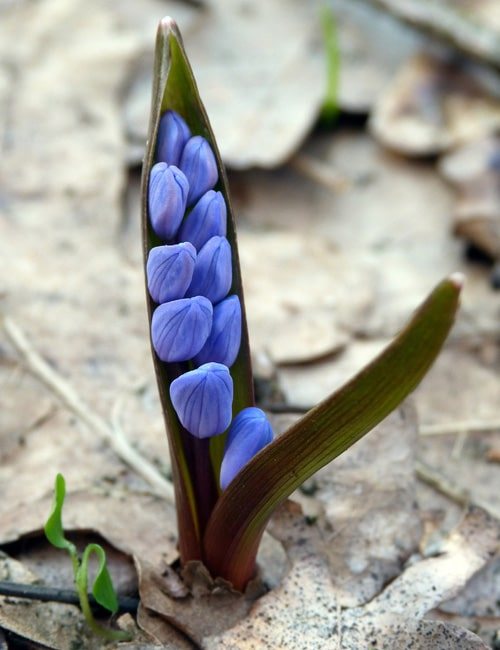

Emerging buds of two-leaved woodland
Taxonomy
| 13 more families (according to the APG III System) | about 80 more species | ||||||||||||
| order Asparagus | genus Proleska | ||||||||||||
| the Department Flowering, or Angiosperms | family Asparagus | view Double-leaved scrub | |||||||||||
| 58 more orders of flowering plants (according to the APG III System) | more than 140 deliveries | ||||||||||||
Synonyms
- Adenoscilla bifolia (L.) Gren. & Godr., 1855
- Adenoscilla nivalis (Boiss.) J. Gay ex Baker, 1873
- Adenoscilla unifolia Texidor, 1869
- Anthericum bifolium (L.) Scop., 1771
- Genlisa bifolia (L.) Raf., 1840
- Hyacinthus bifolius (L.) E. H. L. Krause, 1906, nom. illeg.
- Ornithogalum bifolium (L.) Neck., 1770
- Rinopodium bifolia (L.) Salisb., 1866, nom. inval.
- Scilla alpina Schur, 1852
- Scilla buekkensis Speta, 1976
- Scilla carnea Sweet, 1830
- Scilla cernua Janka, 1855, nom. illeg.
- Scilla chladnii Schur, 1850
- Scilla decidua Speta, 1976
- Scilla dedea Speta, 1991
- Scilla drunensis (Speta) Speta, 1976
- Scilla dubia K. Koch, 1846
- Scilla hohenackeri Janka, 1855, nom. illeg.
- Scilla laxa Schur, 1866
- Scilla longistylosa Speta, 1976
- Scilla lusitanica L., 1767
- Scilla minor K. Koch, 1846
- Scilla montenegrina Speta, 1976
- Scilla nivalis Boiss., 1844
- Scilla pleiophylla Speta, 1980
- Scilla pneumonanthe Speta, 1976
- Scilla praecox Willd., 1799
- Scilla pruinosa Speta, 1991
- Scilla resslii Speta, 1976
- Scilla rosea Lehm., 1828
- Scilla secunda Janka, 1856
- Scilla subnivalis (Halácsy) Speta, 1980
- Scilla subtriphylla Schur, 1866
- Scilla trifolia Schur, 1866
- Scilla uluensis Speta, 1976
- Scilla vernalis Montandon, 1868
- Scilla vindobonensis Speta, 1974
- Scilla xanthandra K. Koch, 1847
- Stellaris bifolia (L.) Moench, 1794
Healing properties
In Russian cities and villages, they make alcohol-based tincture from the inflorescences of blueberry, use it for severe pain in the joints - rubbing the sore joints with the tincture, it relieves pain and tension.
In pharmacology, the plant is used in neurology and ophthalmology. With the help of drugs created with the participation of Scylla, cerebral palsy and poliomyelitis are treated. After treatment, the condition of the body improves, and motor functions are partially restored. But everything must be taken under the supervision of the attending physician. Also, bulbs can help cure a person's cough and diseases of the digestive tract.
It is contraindicated to take it inside: it will cause severe poisoning of the human body, since the plant is poisonous. Actually, before using the tincture, even for rubbing sore joints, it is better to consult with your own local therapist so that there are no sad consequences.
"Autumn scrub"
Autumn view of Scylla, found in the mountains of the North Caucasus, in Asia Minor. The plant can reach a height of 22 cm. It blooms from August to September with small dark lilac or purple flowers. Inflorescence clusters are rare, include from 3 to 15 flowers.


On the above-described varieties, the variety of the Scylla does not end, the cultivated variety of the plant includes the grape Scylla, Pushkiniform, Italian, Bukhara, Chinese, one-flowered and Mishchenko's prolesku.
"Two-leaved forest"
Scylla double-leaved grows in the Mediterranean, in the Crimea, in the Caucasus. A low-growing variety of Scylla two-leaved blooms profusely and luxuriantly, not wasting energy on "extra greenery", but putting it into the cap of the peduncle.
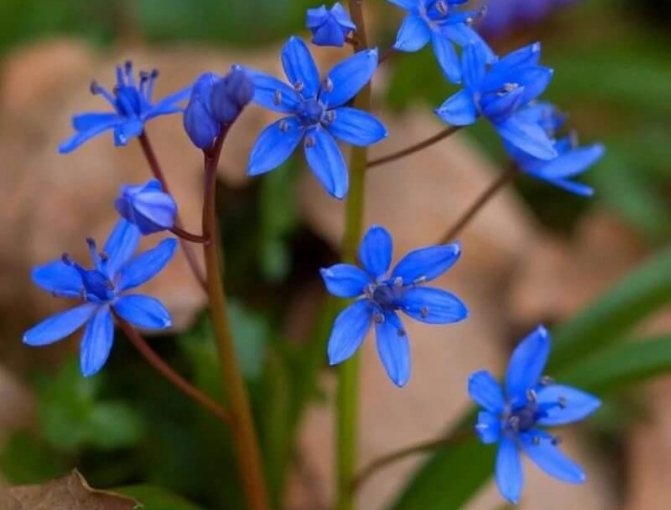

Plant height reaches 15 cm, has up to three peduncles, with white and pink inflorescences. The two-leaved scilla has two wide basal, linear leaves. The two-leaved Scylla includes a purple grove in its group, with bright purple flowers. Blooms for about two weeks.
Botanical confusion
Scylla, which means "sea bow", is a perennial herbaceous primrose. Refers to Asparagus. Although until recently, a number of botanists attributed it to the Hyacinths, while others - to the Liliaceae. Therefore, one can often find different information in the literature.
The origin of the plant's name is also interesting. Some associate it with the name of the ancient Greek goddess Scylla, who, according to legend, drowned in the Mediterranean Sea. And since then, along the shores of the sea grows "sea bow" - scilla. In Russian, the name "Proleska" arose from the fact that the flower grows in the meadows between forest glades. People often confuse him with a snowdrop. According to legend, it is believed that every year Spring and Winter are fighting for power. And now, when Winter loses its severity and is forced to retreat, she sheds tears. And in place of these tears, winter blue flowers appear - the woods.
Be that as it may, the screech invariably pleases us with its blue delicate flowers in early spring. And, thanks to its unpretentiousness, it grows almost everywhere. In the wild, Scylla can be found throughout Russia, as well as in Europe, Asia and some African countries.


Flowering scilla
Where grows
Siberian Proleska is not a whimsical plant. It grows and blooms beautifully on sunny lawns and in the shade of trees. If you do not take care of it, it quickly grows and occupies large territories.
It blooms earlier in open sunny meadows, however, at very high temperatures, the flowering period is reduced. In a shady place, it blooms a little later (due to late melting of snow) and blooms longer. It is not very demanding on soils, but it grows better on loose, fertile soils. On sandy soils, it can freeze slightly when the temperature drops.
Outdoor care
Indoor bride flower - what is the name of the plant?
Although Scylla belongs to unpretentious plants that do not require close attention and care, it can only please with lush and beautiful flowering with proper care.
Scylla should be watered only in the morning so that drops of water do not fall on the flowers. Otherwise, they will no longer be so attractive. Irrigation should not be abundant, since the plant does not like wet soil, but slightly damp soil.
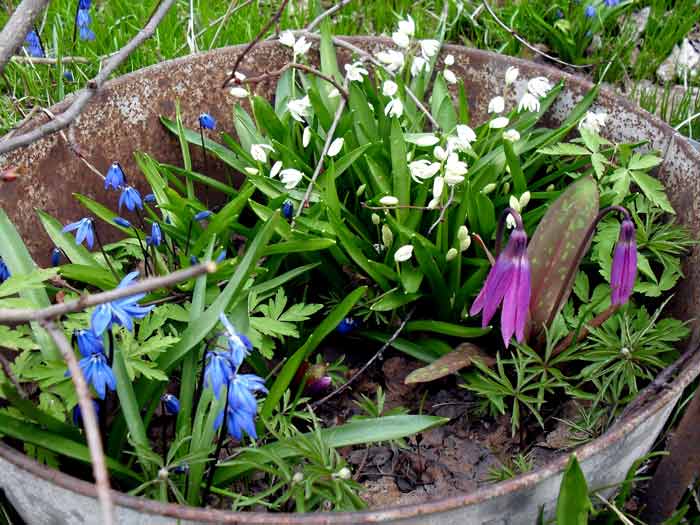

Watering
Watering the scilla should be moderate.
Before the scilla begins to bloom, top dressing is added to the soil with the content:
- potassium,
- phosphorus,
- nitrogen,
- gland,
- magnesium.
If autumn is chosen for fertilization, then preference should be given to granular. In the spring, it is better to use liquid products. Complex preparations are also suitable for Scylla (for example, Nitrofoska). Timely feeding make the flowering abundant and long-lasting. Also, after these procedures, the plants tolerate winter better.
After each watering or heavy rainfall, it is recommended to loosen the soil. The loosening depth should not exceed 2.5 cm. Otherwise, the roots will be deficient in oxygen. Also, the necessary procedure is the removal of weeds, which not only consume nutrients from the soil, but also impede air circulation, contribute to the development of fungal diseases, and the spread of pests.
A necessary measure of caring for the scylla is the timely removal of the testes. Otherwise, the plants will occupy a significant area of the flower bed due to self-seeding reproduction.
Attention! Seed boxes ripen approximately at the end of June. You need to trim them before the peel begins to crack.
Redwoods require transplanting once every 3 years. This procedure promotes healthy growth and preservation of the decorative qualities of plants. The scillas are dug up, the children are separated and planted back into the flowerbed. It is best to do this in late September or early October.
Excerpt from Proleska double-leaved
On dirait que l'humanite a oublie les lois de son divin Sauveur, Qui prechait l'amour et le pardon des offenses, et quelle fait consister son plus grand merite dans l'art de s'entretuer. “Adieu, chere et bonne amie, que notre divin Sauveur et Sainte Mere vous aient en Leur sainte et puissante garde. Marieie ". [Dear and invaluable friend. Your letter of the 13th gave me great joy. You still love me, my poetic Julia. The separation, about which you speak so much badly, evidently did not have its usual influence on you. You complain of separation, what would I have to say if I dared - I, deprived of all those who are dear to me? Ah, if we didn’t have religion for consolation, life would be very sad. Why do you attribute a stern look to me when you speak of your inclination towards a young man? In this respect, I am strict only with myself. I understand these feelings in others, and if I cannot approve of them, having never experienced them, then I do not condemn them. It only seems to me that Christian love, love for one's neighbor, love for enemies, is more worthy, sweeter and better than those feelings that the beautiful eyes of a young man can inspire in a young girl, poetic and loving like you. The news of Count Bezukhov's death reached us before your letter, and my father was very touched by him. He says that this was the penultimate representative of the great age, and that now it is his turn, but that he will do everything in his power to make this turn come as late as possible. God save us from this misfortune. I cannot share your opinion about Pierre, whom I knew as a child. It seemed to me that he always had a wonderful heart, and this is the quality that I value most in people. As for his inheritance and the role played by Prince Vasily in this, it is very sad for both. Ah, dear friend, the words of our Divine Savior that it is easier for a camel to get into a needle's ear than for a rich man to enter the kingdom of God - these words are terribly just. I pity Prince Vasily and even more Pierre.For such a young man to be weighed down by such a huge state - how many temptations he will have to go through! If someone asked me what I desire more than anything in the world, I want to be poorer than the poorest of the poor. Thank you a thousand times, dear friend, for the book that you are sending me and which makes so much noise with you. However, since you tell me that among many good things in it there are those that the weak human mind cannot comprehend, it seems to me unnecessary to engage in incomprehensible reading, which, for this very reason, could not bring any benefit. I could never understand the passion that some persons have, to confuse my thoughts, addicted to mystical books, which only arouse doubts in their minds, irritate their imaginations and give them a character of exaggeration, completely contrary to Christian simplicity. Let's read the Apostles and the Gospel better. We will not try to penetrate what is mysterious in these books, for how can we, miserable sinners, learn the terrible and sacred secrets of Providence as long as we wear that fleshly shell that raises an impenetrable veil between us and the Eternal? We better confine ourselves to studying the great rules that our Divine Savior has left for us to guide us here on earth; we will try to follow them and try to make sure that the less we give rampant to our minds, the more pleasing we will be to God, Who rejects all knowledge that does not come from Him, and that the less we delve into what He was pleased to hide from us, the sooner He will give us this revelation by His divine mind.
Scylla after flowering


After the plant has faded, the peduncle must be removed from it, while the leaf plates are cut off only after they have completely died out. There is no need to prepare the Scylla for the coming winter in a special way, because it has a fairly high frost resistance and does not need shelter. However, if these flowers are cultivated in an open area, then to protect them from winter frosts, it is recommended to cover them with dried foliage or spruce branches.
Scylla "Bell-shaped" (Endymion Spanish)
The "bell-shaped" scilla or "Spanish endymion" originates from the forests of Spain, Portugal and France. The plant can be considered one of the most beautiful types of woodland.
A medium-sized peduncle is decorated with blue or pink flowers, in the form of a large bell 2-3 cm in size. There can be up to 8 flowers on one peduncle, making up a wonderful "fluffy" bunch.
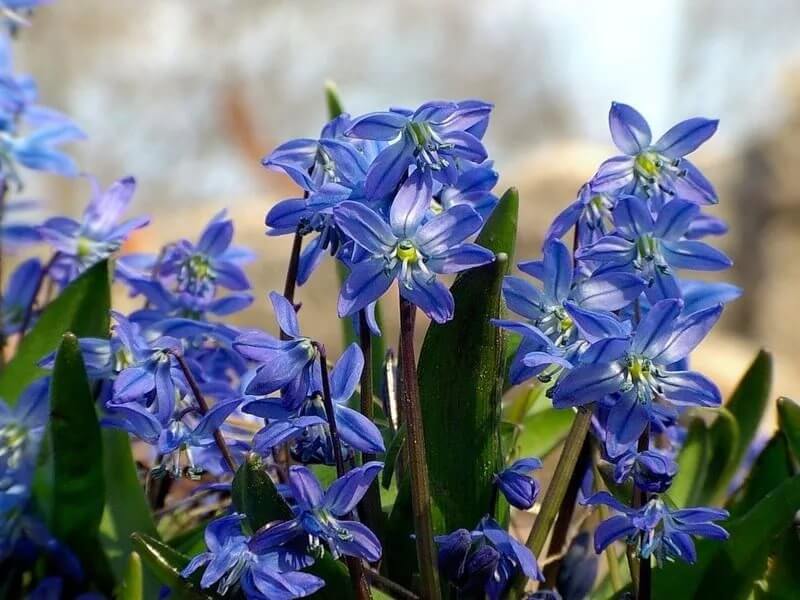

The bell-shaped scylla begins to bloom in late May and ends in June. A variety of bell-shaped varieties cannot but delight the eye and delights flower growers.
The most popular varieties of the bell-shaped scilla are called:
Sky Blue, a variety with large sky-blue flowers and blue veins located on large peduncles.
Rose Queen, a vibrant variety with pink flowers and lavender hues.
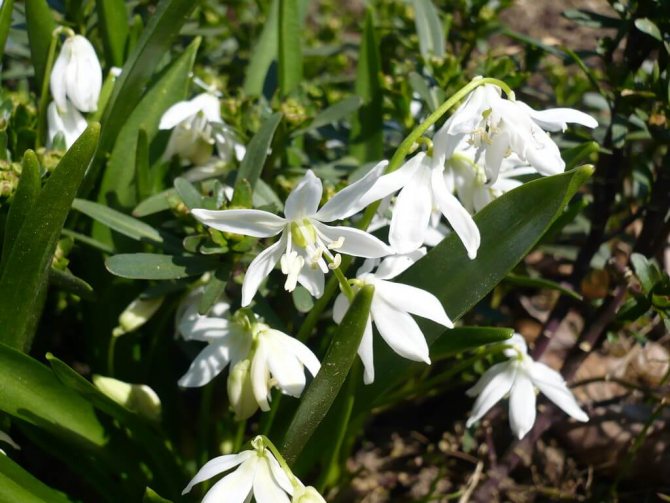

La Gradens, will surprise you with large white flowers, collected in lush brushes, and a delicate aroma.
Rosabella, pink-lilac flowers in inflorescences, will fill the garden with a fragrance. Plant height up to 25 cm. The variety is in demand among florists and landscape designers.
In addition to the above, the bell-shaped Scylla includes woodland varieties: Everest, Blue Pearl, Blue Queen, Blue Giant, Queen Pinks and others.

